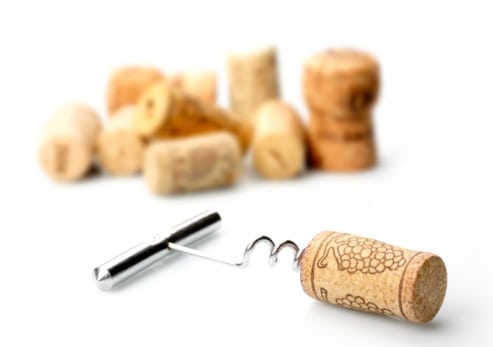Have you ever opened a bottle of wine expecting a delicious and aromatic beverage, only to find that it tastes and smells like a moldy basement or wet cardboard?
Then you have had the unfortunate experience of having a cork tainted wine. A ‘corked wine’ started out with perfectly good juice that went into the bottle, only to be spoiled by a compound (TCA) found in some corks. TCA is a chemical compound (2, 4, 6 – trichloroanisole) that makes perfectly good wine taste and smell terrible.
Though harmless, TCA can be naturally present in cork, wood, fruits and vegetables. Prepackaged vegetables from the supermarket are loaded with TCA. A common offender is bagged baby carrots, which often give the same moldy basement aromas associated with TCA. Luckily, when they are cooked and sauced, the unpleasant flavors and aromas are masked or cooked away. But with wine, these flavors ruin the experience and the bottle is rendered undrinkable.
The biggest fear for a winemaker, who has spent a year in the vineyard and cellar trying to make the finest product they can produce, is that the consumer will not know that the bottle is cork tainted and just assume they don’t like said winemaker’s wine and never purchase that brand’s wine again.
The industry standard for corked bottles is between 3 percent and 10 percent, depending if you talk to the cork industry or wine producers. Either percentage is unacceptable. If 10 percent of the milk you purchased was bad because of the closure, or one in ten steaks you purchased from the butcher was bad because of the paper they wrapped it in, this would be unacceptable. The milk closure or paper wrapper would be replaced with a more suitable packaging.
So why is this allowed in the world of wine? Why is there a double standard for oenophiles? My experience over the last twenty-something years in the industry has led me to believe the percentage of corked wine is somewhere between 3 percent – 10 percent, with the incidence being much higher in the $10 bottle of mass-produced wine, and lower in a premium, small-production bottling.
What is cork? Technically it is bark from a cork oak tree most commonly found in Portugal. Given the ever increasing demand for corks, cork oak farmers are lowering their standards for farming and have helped exasperate this problem. Cork oak bark is supposed to be harvested from mature trees (25-30 year old) every nine years and must be several feet above ground, to ensure the TCA compound commonly found in soil isn’t present in the bark.
However, the pressure to keep up with demand has persuaded many farmers to sell inferior, immature cork grown close to the ground in the marketplace. These shortcuts have helped cause the rise in corked wines. Corks can range in price from pennies to up to a couple dollars each depending on quality and size. So clearly, not all corks are created equally.
Are synthetic corks the answer? Many producers a decade or two ago thought so and converted to synthetic cork closures only to find they had their own set of drawbacks including premature oxidation issues and consumer misconceptions. What producers didn’t know was that some synthetic corks shrank in size minuscule amounts a year or two after being placed into a bottle, only to allow tiny amounts of oxygen to come into contact with the wine, thus turning it into vinegar. Sadly, this put a few top quality wineries out of business.
Now, synthetic corks are produced in a different and better way that doesn’t cause this premature-oxidation issue, but consumer skepticism remains.
Some wine producers believe in a glass cork called Vinolok. Vinolok was created in 2003 by Alcoa and is commonly used in Austria and to a lesser extent in Germany. One Napa Valley producer, Von Strasser, bottles their Diamond Mountain District Cabernet Sauvignon ($50) with this glass cork, fitted with a small plastic o-ring, so that cork taint will never be an issue. However, the Vinolok is expensive, requires manual bottling due to the lack of compatible equipment among common bottling lines and hasn’t been proven to properly age wines due to its relative newness.
Finally, there is the dreaded screw cap, the Rodney Dangerfield of wine closures. It gets zero respect from consumers, collectors and sommeliers. However, it might be the most sustainable, affordable and foolproof method of enclosing a wine. Also known as the Stelvin closure, it doesn’t require a knife and small tool to extract a wedged hunk of tree bark from the neck. You’ll never get a corked bottle. And, studies have proven that wines age slower and better under Stelvin than cork. Twenty-five year trials have been done with some of Australia’s top wines comparing cork and Stelvin and found those with screw caps appear more youthful, bright and vibrant, than their counterparts with nature cork.
But, many consumers associate screw caps with cheap, inferior wines.
Luckily, some maverick producers such as PlumpJack are bottling their premium reserve Napa Valley Cabernet Sauvignon ($300) with the Stelvin closure. Hopefully, other wineries will choose this same approach and seek out better, more reliable and sustainable ways to cap their wines, so wine drinkers can make cork tainted wines a thing of the past. M
—Kevin Pelley, Certified Sommelier,
Manager: Bern’s Fine Wines & Spirits
www.bernsfinewines.com
© Tampa Bay Metro Magazine | A Metro Life Media, Inc. Publication





